A
Auto Express
Guest
SUVs win sales, which is why Hyundai is bolstering its line-up with the all-new Bayon compact crossover, a challenger to the Renault Captur, Ford Puma and Peugeot 2008.
These rivals show how crowded this sector of the market is already, but the Hyundai Bayon uses plenty of modern technology, with strong connectivity, mild-hybrid engines and protective safety tech to keep it competitive. It’s wrapped up in a sharp-looking body that further evolves Hyundai’s design language.
Like the brand’s larger Tucson SUV, lighting is key to the look here, with slim running lights above the larger, angled main units. Sharp creases on the car’s flanks are reminiscent of its bigger brother too, while the arrow-shaped taillights – linked by a full-width strip – reference the i20 supermini.
At 4,180mm long and 1,775mm wide the Bayon’s dimensions are compact, with a smaller footprint than its main rivals mentioned above and sitting below the firm’s own Kona SUV when it comes to size.
The Bayon is therefore closer in size to a supermini as, although being 140mm longer than the i20, it's the same width. The Korean brand claims to have maximised packaging in its new crossover, freeing up 411 litres of boot space and plenty of legroom inside, with a 2,580mm wheelbase. This increases to 1,205 litres by folding the rear seats down.
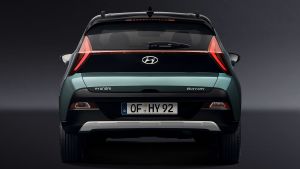
Hyundai Bayon - full rear
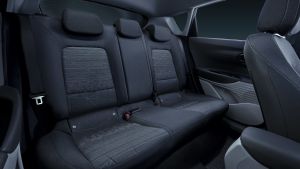
Hyundai Bayon - rear seats
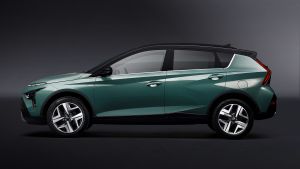
Hyundai Bayon - side
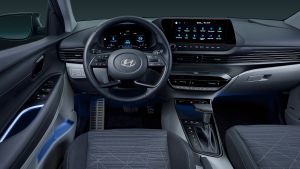
Hyundai Bayon - dash
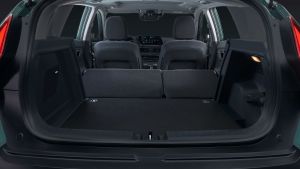
Hyundai Bayon - boot 3
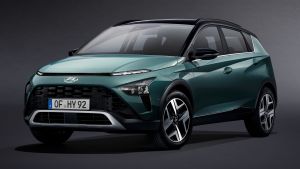
Hyundai Bayon - front
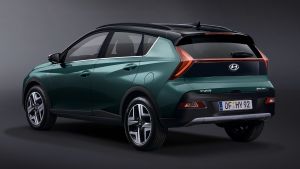
Hyundai Bayon - rear static
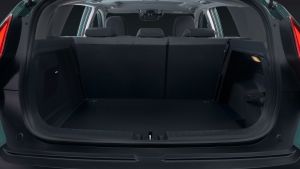
Hyundai Bayon - boot
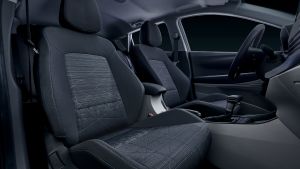
Hyundai Bayon - front seats
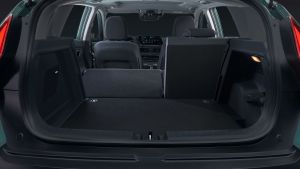
Hyundai Bayon - boot 2
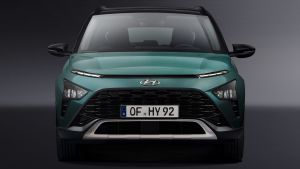
Hyundai Bayon - full front

Hyundai Bayon - front static
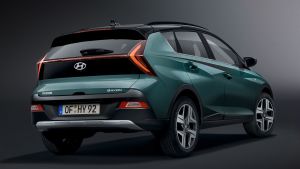
Hyundai Bayon - rear
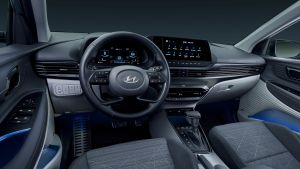
Hyundai Bayon - cabin
Standing 1,490mm tall it should offer good forward visibility thanks to a more commanding driving position, while Hyundai claims that with up to 183mm of ground clearance when fitted with 17-inch alloy wheels (16-inch alloys or 15-inch steel wheels will also be available depending on trim) it’s a true SUV.
“With its sharp look and integration of Hyundai’s SUV key design elements, Bayon solidifies Hyundai’s SUV design direction,” said Hyundai’s Chief Creative Office, Luc Donckerwolke.
The Bayon inherits tech from the i20 line-up, with two different infotainment set-ups available. The first is an eight-inch touchscreen that feature Android Auto and wireless Apple CarPlay (a first for this segment, according to Hyundai), using your smartphone for navigation. The second is a 10.25-inch touchscreen system featuring built-in navigation, with similar device connectivity.
A 10.25-inch digital instrument panel will feature, while an upgraded Bose sound system and wireless charging will be on offer too, depending on trim level.
All models get three USB ports – two in the front and one in the rear, so passengers can keep their devices charged independently of the device being used for connectivity purposes.

Hyundai Bayon - full rear

Hyundai Bayon - rear seats

Hyundai Bayon - side

Hyundai Bayon - dash

Hyundai Bayon - boot 3

Hyundai Bayon - front

Hyundai Bayon - rear static

Hyundai Bayon - boot

Hyundai Bayon - front seats

Hyundai Bayon - boot 2

Hyundai Bayon - full front

Hyundai Bayon - front static

Hyundai Bayon - rear

Hyundai Bayon - cabin
Hyundai is ramping up the connectivity element with its latest Bluelink suite of services. This means Bayon owners can create their own user profiles, as well as syncing their phone’s Google or Apple calendar with the car – if a calendar entry has an address associated with it, this info can be imported into the car’s sat-nav.
Connected Routing is also on offer, which uses cloud-based navigation for more precise guidance, while Live Parking info will give you prices and availability for parking nearby, including on-street parking for this generation of the tech.
The usual remote services package (locking and unlocking your car from your phone), voice recognition and POI info also feature.
The Bayon’s tech extends to the level of protection on offer. This compact SUV will likely be used by families, so there are plenty of Hyundai’s SmartSense active safety systems available to protect occupants. Full UK equipment specifications haven’t yet been confirmed, but when it comes to safety systems Hyundai says, “many of them are included in the standard equipment already.”
These include lane keep assist, semi-autonomous lane follow assist, collision avoidance with pedestrian and cyclist detection plus autonomous emergency braking, high beam assist, a driver attention warning, blind-spot warning and rear cross-traffic alert.

Hyundai Bayon - full rear

Hyundai Bayon - rear seats

Hyundai Bayon - side

Hyundai Bayon - dash

Hyundai Bayon - boot 3

Hyundai Bayon - front

Hyundai Bayon - rear static

Hyundai Bayon - boot

Hyundai Bayon - front seats

Hyundai Bayon - boot 2

Hyundai Bayon - full front

Hyundai Bayon - front static

Hyundai Bayon - rear

Hyundai Bayon - cabin
There’s also a rear-seat occupant alert, which detects movement in the back seats and notifies the driver before leaving the car, while the Bayon will also warn you of cars moving off in front of you in a queue in case you don’t notice.
It’s no surprise that the Bayon shares much of its engine line-up with the brand’s i20 supermini, with a 1.0-litre three-cylinder turbocharged engine bolstered by 48-volt mild-hybrid technology.
However, as well as the 99bhp powertrain available in the i20 line-up, the Bayon also features a 118bhp variant. The car will be offered with Hyundai’s six-speed iMT intelligent manual transmission and a seven-speed dual-clutch automatic gearbox.
The former set-up does away with a physical linkage between the clutch pedal and the clutch disc that sits between the engine and the gearbox, replacing this with electronic sensors and actuators to engage and disengage the clutch.
It means that the Bayon can support engine-off coasting while in gear when the driver is off the throttle to help boost efficiency.
Our experience of this system in the i20 is positive, with the tech responding like a normal manual, but cutting the engine cleverly and reigniting it quickly when you touch the brake or the throttle pedal.

Hyundai Bayon - full rear

Hyundai Bayon - rear seats

Hyundai Bayon - side

Hyundai Bayon - dash

Hyundai Bayon - boot 3

Hyundai Bayon - front

Hyundai Bayon - rear static

Hyundai Bayon - boot

Hyundai Bayon - front seats

Hyundai Bayon - boot 2

Hyundai Bayon - full front

Hyundai Bayon - front static

Hyundai Bayon - rear

Hyundai Bayon - cabin
There are three different driving modes available – Eco, Normal and Sport – with the latter featuring a rev matching function for the iMT gearbox.
Both engines offer the same torque output of 172Nm. The 99bhp 1.0 T-GDi model will accelerate from 0-62mph in 10.7 seconds with the six-speed iMT gearbox, while the seven-speed DCT takes a second longer to cover the benchmark sprint.
The 118bhp variant shaves three tenths of a second off its less powerful sibling’s respective 0-62mph times in both manual and automatic form.
Fuel economy is still to be confirmed, but CO2 emissions have been outlined. The 99bhp 1.0 T-GDi 48v unit will emit as little as 118g/km with the iMT transmission, rising to a best of 120g/km for the DCT-equipped car.
Unsurprisingly, the 118bhp model is slightly less efficient – but only slightly, emitting 119g/km CO2 in manual trim. Emissions for the automatic are TBC.
Hyundai hasn’t yet confirmed when its new compact crossover will go on sale, but order books are likely to open mid-summer with prices expected to start from around £20,000, roughly a £1,500 increase over the i20 supermini.
Click here for our in-depth review of the Hyundai Kona crossover...
Continue reading...
These rivals show how crowded this sector of the market is already, but the Hyundai Bayon uses plenty of modern technology, with strong connectivity, mild-hybrid engines and protective safety tech to keep it competitive. It’s wrapped up in a sharp-looking body that further evolves Hyundai’s design language.
Like the brand’s larger Tucson SUV, lighting is key to the look here, with slim running lights above the larger, angled main units. Sharp creases on the car’s flanks are reminiscent of its bigger brother too, while the arrow-shaped taillights – linked by a full-width strip – reference the i20 supermini.
At 4,180mm long and 1,775mm wide the Bayon’s dimensions are compact, with a smaller footprint than its main rivals mentioned above and sitting below the firm’s own Kona SUV when it comes to size.
The Bayon is therefore closer in size to a supermini as, although being 140mm longer than the i20, it's the same width. The Korean brand claims to have maximised packaging in its new crossover, freeing up 411 litres of boot space and plenty of legroom inside, with a 2,580mm wheelbase. This increases to 1,205 litres by folding the rear seats down.

Hyundai Bayon - full rear

Hyundai Bayon - rear seats

Hyundai Bayon - side

Hyundai Bayon - dash

Hyundai Bayon - boot 3

Hyundai Bayon - front

Hyundai Bayon - rear static

Hyundai Bayon - boot

Hyundai Bayon - front seats

Hyundai Bayon - boot 2

Hyundai Bayon - full front

Hyundai Bayon - front static

Hyundai Bayon - rear

Hyundai Bayon - cabin
Standing 1,490mm tall it should offer good forward visibility thanks to a more commanding driving position, while Hyundai claims that with up to 183mm of ground clearance when fitted with 17-inch alloy wheels (16-inch alloys or 15-inch steel wheels will also be available depending on trim) it’s a true SUV.
“With its sharp look and integration of Hyundai’s SUV key design elements, Bayon solidifies Hyundai’s SUV design direction,” said Hyundai’s Chief Creative Office, Luc Donckerwolke.
New Hyundai Bayon: technology and connectivity
The Bayon inherits tech from the i20 line-up, with two different infotainment set-ups available. The first is an eight-inch touchscreen that feature Android Auto and wireless Apple CarPlay (a first for this segment, according to Hyundai), using your smartphone for navigation. The second is a 10.25-inch touchscreen system featuring built-in navigation, with similar device connectivity.
A 10.25-inch digital instrument panel will feature, while an upgraded Bose sound system and wireless charging will be on offer too, depending on trim level.
All models get three USB ports – two in the front and one in the rear, so passengers can keep their devices charged independently of the device being used for connectivity purposes.

Hyundai Bayon - full rear

Hyundai Bayon - rear seats

Hyundai Bayon - side

Hyundai Bayon - dash

Hyundai Bayon - boot 3

Hyundai Bayon - front

Hyundai Bayon - rear static

Hyundai Bayon - boot

Hyundai Bayon - front seats

Hyundai Bayon - boot 2

Hyundai Bayon - full front

Hyundai Bayon - front static

Hyundai Bayon - rear

Hyundai Bayon - cabin
Hyundai is ramping up the connectivity element with its latest Bluelink suite of services. This means Bayon owners can create their own user profiles, as well as syncing their phone’s Google or Apple calendar with the car – if a calendar entry has an address associated with it, this info can be imported into the car’s sat-nav.
Connected Routing is also on offer, which uses cloud-based navigation for more precise guidance, while Live Parking info will give you prices and availability for parking nearby, including on-street parking for this generation of the tech.
The usual remote services package (locking and unlocking your car from your phone), voice recognition and POI info also feature.
New Hyundai Bayon: safety
The Bayon’s tech extends to the level of protection on offer. This compact SUV will likely be used by families, so there are plenty of Hyundai’s SmartSense active safety systems available to protect occupants. Full UK equipment specifications haven’t yet been confirmed, but when it comes to safety systems Hyundai says, “many of them are included in the standard equipment already.”
These include lane keep assist, semi-autonomous lane follow assist, collision avoidance with pedestrian and cyclist detection plus autonomous emergency braking, high beam assist, a driver attention warning, blind-spot warning and rear cross-traffic alert.

Hyundai Bayon - full rear

Hyundai Bayon - rear seats

Hyundai Bayon - side

Hyundai Bayon - dash

Hyundai Bayon - boot 3

Hyundai Bayon - front

Hyundai Bayon - rear static

Hyundai Bayon - boot

Hyundai Bayon - front seats

Hyundai Bayon - boot 2

Hyundai Bayon - full front

Hyundai Bayon - front static

Hyundai Bayon - rear

Hyundai Bayon - cabin
There’s also a rear-seat occupant alert, which detects movement in the back seats and notifies the driver before leaving the car, while the Bayon will also warn you of cars moving off in front of you in a queue in case you don’t notice.
New Hyundai Bayon: engines, performance and CO2
It’s no surprise that the Bayon shares much of its engine line-up with the brand’s i20 supermini, with a 1.0-litre three-cylinder turbocharged engine bolstered by 48-volt mild-hybrid technology.
However, as well as the 99bhp powertrain available in the i20 line-up, the Bayon also features a 118bhp variant. The car will be offered with Hyundai’s six-speed iMT intelligent manual transmission and a seven-speed dual-clutch automatic gearbox.
The former set-up does away with a physical linkage between the clutch pedal and the clutch disc that sits between the engine and the gearbox, replacing this with electronic sensors and actuators to engage and disengage the clutch.
It means that the Bayon can support engine-off coasting while in gear when the driver is off the throttle to help boost efficiency.
Our experience of this system in the i20 is positive, with the tech responding like a normal manual, but cutting the engine cleverly and reigniting it quickly when you touch the brake or the throttle pedal.

Hyundai Bayon - full rear

Hyundai Bayon - rear seats

Hyundai Bayon - side

Hyundai Bayon - dash

Hyundai Bayon - boot 3

Hyundai Bayon - front

Hyundai Bayon - rear static

Hyundai Bayon - boot

Hyundai Bayon - front seats

Hyundai Bayon - boot 2

Hyundai Bayon - full front

Hyundai Bayon - front static

Hyundai Bayon - rear

Hyundai Bayon - cabin
There are three different driving modes available – Eco, Normal and Sport – with the latter featuring a rev matching function for the iMT gearbox.
Both engines offer the same torque output of 172Nm. The 99bhp 1.0 T-GDi model will accelerate from 0-62mph in 10.7 seconds with the six-speed iMT gearbox, while the seven-speed DCT takes a second longer to cover the benchmark sprint.
The 118bhp variant shaves three tenths of a second off its less powerful sibling’s respective 0-62mph times in both manual and automatic form.
Fuel economy is still to be confirmed, but CO2 emissions have been outlined. The 99bhp 1.0 T-GDi 48v unit will emit as little as 118g/km with the iMT transmission, rising to a best of 120g/km for the DCT-equipped car.
Unsurprisingly, the 118bhp model is slightly less efficient – but only slightly, emitting 119g/km CO2 in manual trim. Emissions for the automatic are TBC.
New Hyundai Bayon: prices and on-sale date
Hyundai hasn’t yet confirmed when its new compact crossover will go on sale, but order books are likely to open mid-summer with prices expected to start from around £20,000, roughly a £1,500 increase over the i20 supermini.
Click here for our in-depth review of the Hyundai Kona crossover...
Continue reading...
